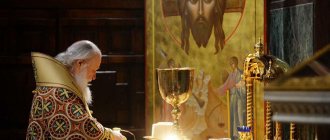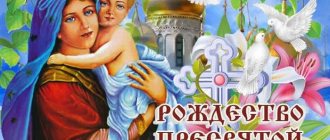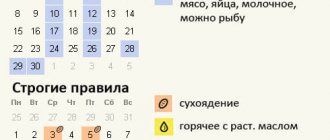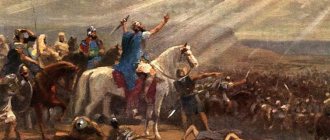How are the twelve holidays classified?
A) According to their content, the twelve feasts are divided into the Lord's and the Theotokos.
The Lord's holidays were established by the Church for the glory of the Lord Jesus Christ and reflect the most important events from His earthly life. These include:
- Nativity of Christ (December 25 / January 7),
- Epiphany (January 6 / January 19),
- Transfiguration of the Lord (August 6/August 19),
- Exaltation of the Holy Cross (September 14 / September 27),
- Entry of the Lord into Jerusalem (date of celebration depends on the date of Easter),
- Ascension of the Lord (date of celebration depends on the date of Easter),
- Pentecost (Holy Trinity Day) (the date of celebration depends on the date of Easter).
In turn, the Mother of God holidays are dedicated to the glorification of the Mother of God and reflect events from the earthly life of the Blessed Virgin Mary:
- Nativity of the Blessed Virgin Mary (September 8/21),
- Entry into the Temple of the Blessed Virgin Mary (November 21 / December 4),
- Annunciation of the Blessed Virgin Mary (March 25/April 7),
- Presentation of the Lord (2/15 Feb.),
- Dormition of the Blessed Virgin Mary (August 15/28).
Let us note that the feast of the Presentation of the Lord and the feast of the Annunciation are often interpreted as the Lord's Mother of God.
B) According to their position in the system of holidays of the church year, the twelve feasts are divided into “fixed” (non-movable), that is, having a fixed date, and “movable” (transitionable), that is, tied to the Easter cycle.
What is the twelfth holiday?
Estimated reading time: 3 minutes.
What is the twelfth holiday? Why are there twelve of them? What is the difference from the greats? Why were these holidays named like that, what do they have in common?
Archpriest Igor FOMIN
Every day the church celebrates the memory of a saint or some event. And any church celebration has a deep meaning - this, by the way, is what distinguishes our holidays from secular ones. The fact is that church holidays are always edifying, they educate a person, put him in the right mood and encourage him to do good deeds.
I will say in the words of Justin Popovich: every day we celebrate the memory of some saint - and it’s as if they are passing us from hand to hand. In order for us to grow in God, from strength to strength, to ascend the spiritual ladder.
To better understand what the twelve holidays are, let’s look for their analogue in the secular calendar. Could City Day be such an analogue? No. A completely incomprehensible holiday, fun with a reason, but without a reason - without meaning. Likewise, New Year, for example, is a holiday beloved by everyone, but empty: make noise at night, sit at a rich table, and in the morning sweep up the dishes that the guests have broken from the floor. Perhaps the only holiday that can be compared with the Twelve Holidays is May 9. Victory Day also inspires, instructs, and gives life guidelines. When we hear its very name “Victory Day”, everything inside responds. Similar feelings arise in the soul of a believer when he hears the phrase “twelfth holidays.” Let's list them:
- Nativity of the Virgin Mary - September 8 (21);
- Exaltation of the Holy Cross - September 14 (27);
- Presentation of the Blessed Virgin Mary into the temple - November 21 (December 4);
- Christmas - December 25 (January 7);
- Epiphany of the Lord - January 6 (19);
- Presentation of the Lord - February 2 (15);
- Annunciation of the Blessed Virgin Mary - March 25 (April 7);
- The Entry of the Lord into Jerusalem—the Sunday before Easter—transitionable;
- Ascension of the Lord - the 40th day after Easter, always on Thursday - moving;
- Trinity Day - the 50th day after Easter, always on Sunday - moving;
- Transfiguration of the Lord - August 6 (19);
- Dormition of the Virgin Mary - August 15 (28).
Dogmatically, these holidays are closely connected with the events of the earthly life of the Lord Jesus Christ; they morally set us up in a positive way and educate us. And, most importantly, through their content they lead us to Christ.
In general, the church calendar has its own hierarchy of memorable dates. Holidays The holiday - Easter - is not one of the twelve, but stands, as it were, at the head of them all. Further along the hierarchical ladder come the Twelveth, then the Great, and finally the holidays associated with the names of saints.
In addition, the twelve feasts themselves are divided into the Lord's and the Theotokos. They are special both in worship and symbolism.
For us, these days are the peaks of joy in the year, the peaks of rejoicing, approaching Christ, and our salvation. We celebrate the fact that the Lord paid attention to us. The fact that the Mother of God, the same as we, being human, has become in the Kingdom of Heaven the one to whom we turn “Save us,” and do not ask for prayer before the throne of God, like other saints.
On the twelve holidays we celebrate the fact that a person already here on earth can unite with God and become deified. They give us hope, awaken love in our hearts and strengthen faith. Well, I’m not even talking about wisdom - sophia: in every church holiday there is hidden an extraordinary depth of wisdom.
Photo about. Igor Fomin: www.foma.ru
Photo in the announcement: Ginnyt, photosight.ru
Which twelve holidays are included in the list of fixed (immovable) holidays?
- Nativity of the Blessed Virgin Mary (Sept. 8/21),
- Exaltation of the Holy Cross (Sept. 14/27),
- Entry into the Temple of the Blessed Virgin Mary (November 21 / December 4),
- Nativity of Christ (December 25 / January 7),
- Epiphany, or Epiphany (Jan 6/19),
- Presentation of the Lord (2/15 Feb.),
- Annunciation of the Blessed Virgin Mary (March 25/April 7),
- Transfiguration of the Lord (6/19 Aug.) and
- Dormition of the Blessed Virgin Mary (August 15/28).
Twelfth Moving Holidays
| Entry of the Lord into Jerusalem, or 'Palm Sunday' | A week before Easter, or the 6th Sunday of Lent |
| Ascension of the Lord | Celebrated on the 40th day after Easter |
| Trinity Day, or 'Pentecost' | 50th day after Easter |
In addition to the twelfth holidays of the Orthodox Church, there are also Great (or non-twelfth) holidays. They are also revered by Orthodox Christians.
Great church holidays with a constant date according to the new style
- January 14 - Circumcision of the Lord
- July 7 - Nativity of John the Baptist
- July 12 - Feast of the Holy Chief Apostles Peter and Paul
- September 11 - Beheading of John the Baptist
- October 14 - Intercession of the Most Holy Theotokos and Ever-Virgin Mary
On the icon, the events of the twelve holidays are placed around the perimeter. In the middle, a fragment of Great Easter is traditionally depicted.
Which twelve holidays are included in the list of movable (transitionable) holidays?
3 holidays are called “movable”:
- Entry of the Lord into Jerusalem (on the Sunday preceding Easter),
- Ascension of the Lord (40th day from Easter, always on Thursday) and
- Holy Trinity Day (50th day from Easter, always on Sunday).
How did the dates of permanent holidays appear?
Not all holidays in the Church correspond to historical or even gospel chronology. By setting the dates of holidays, the Church sometimes pursued pedagogical or missionary goals. Thus, the Transfiguration of the Lord, which, according to the Holy Scriptures, occurred before Easter, is celebrated much later - on August 19. This holiday was deliberately moved to the end of the grape harvest in the Mediterranean regions in order to supplant the pagan festivities - “bacchanalia”. The Nativity of Christ also began to be celebrated on the day of the pagan holiday of the Sun, and not on the actual birthday of Christ (it is unknown, since previously in the East the date of birth was not given much importance).
But the date of the Annunciation has already been established as a day nine months before Christmas.
Therefore, the dates of the fixed twelfth holidays cannot be considered historically correct - this is how the church tradition developed for one reason or another.
When did the system of twelve feasts form in the Church?
Since ancient times, the holy fathers especially highlighted certain holidays dedicated to the most important events in the earthly life of Jesus Christ. Until the 10th century there were less than 12 such holidays. In later times, 12 or more holidays were called (in particular, the Feast of the Last Supper, the Feast of New Week - Assurance of Thomas), and their composition changed. The system of twelve feasts was finally formed in the liturgical practice of the Orthodox Church by the 16th–17th centuries.
Questions and answers
| What does the twelfth holiday mean, why is it called that? |
| Orthodox celebrations, which are included in the 12 main highly revered dates, the reason for the appearance of which were the events of the earthly life of the Son of God and the Mother of God. |
| Is Easter Sunday considered one of the main twelve holidays? |
| No, this celebration stands alone and is honored above all other Orthodox dates. |
| Is it necessary to fast during the twelfth period? |
| Some dates fall during strict fasting. For example, on the eve of Epiphany, if your health allows, you need to spend the whole day on the water. But this does not apply to all twelve. The most important thing when celebrating church celebrations is not to indulge in gluttony. |
| Why is it advisable not to attend social entertainment events? |
| This must be done so that the connection with the Lord is stronger, and then one can hope for his help in all endeavors. |









